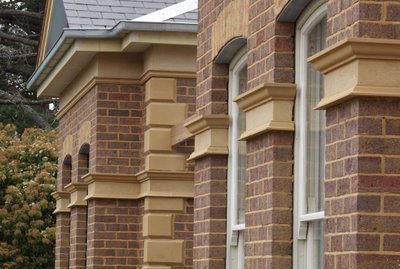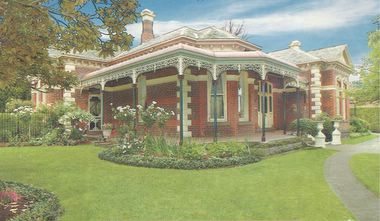Exterior Mouldings

I think I've said this before, but of all the decisions on the house design, the ones associated with brickwork and associated mouldings were the most difficult. It caused many "discussions"!
Traditional Victorian homes usually featured extensive exterior mouldings, as labour was cheap in the 19'th century. These days, light-weight stick-on moulding are used a lot on new homes, but these didn't deliver the aesthetics we required. Instead, we opted for a sandstone product, made by grinding sandstones, and moulding it into a range of shapes. The qoins on the corners of the house, the "stinger-mould" about three-quarters of the way up the wall, and another one placed four brick-courses under the eaves are all made from this sandstone product.
The qoins are laid into the brickwork, but the stringer mouldings are attached with a 2-part adhesive (Australian Standards require 2-pack adhesives for external mouldings fixed above a certain height). To hold the mouldings while the adhesive goes-off, "dutch-clamps" are used. This was very tediuous work, and required a lot of patience and skill from our solid-renderer who did the work. Both stringer courses also have a render-treament applied to complete the effect.
A final comment about the mouldings - they look fantastic, they make our house a one-off, but we could have had an in-ground swimming pool for the same cost!!


3 Comments:
Hello from the USA. Love the house! Looks like the two of you are doing a great job as owner-builders.
I'm not a fellow renovator but I do love to follow along. I love the sandstone mouldings. You've done a fabulous job and I am eager to continue following your progress.
Pah to the pool - you made the right decision !
Post a Comment
<< Home